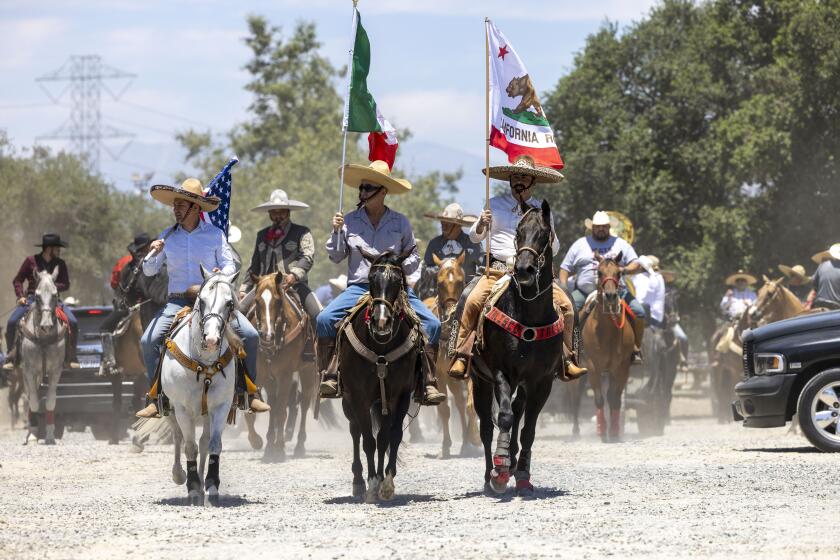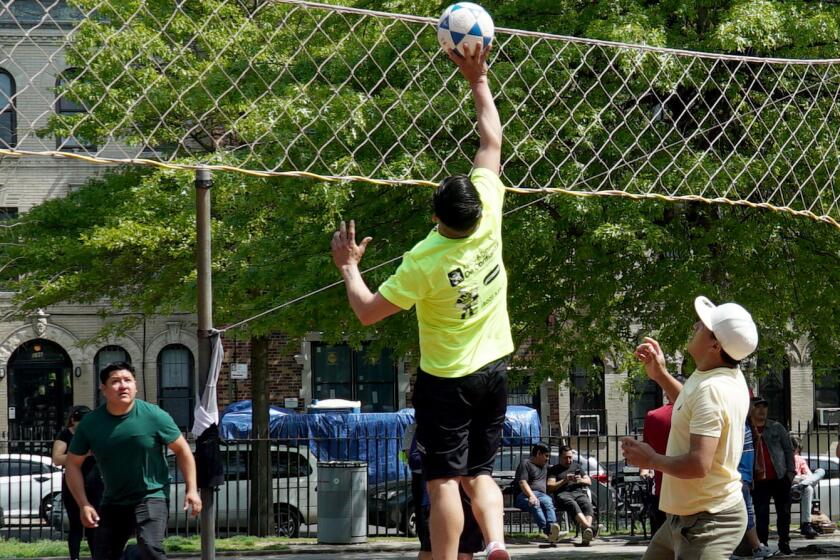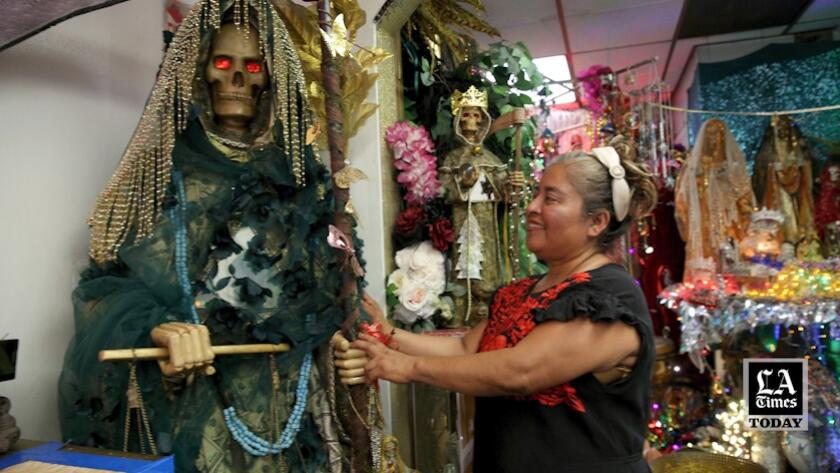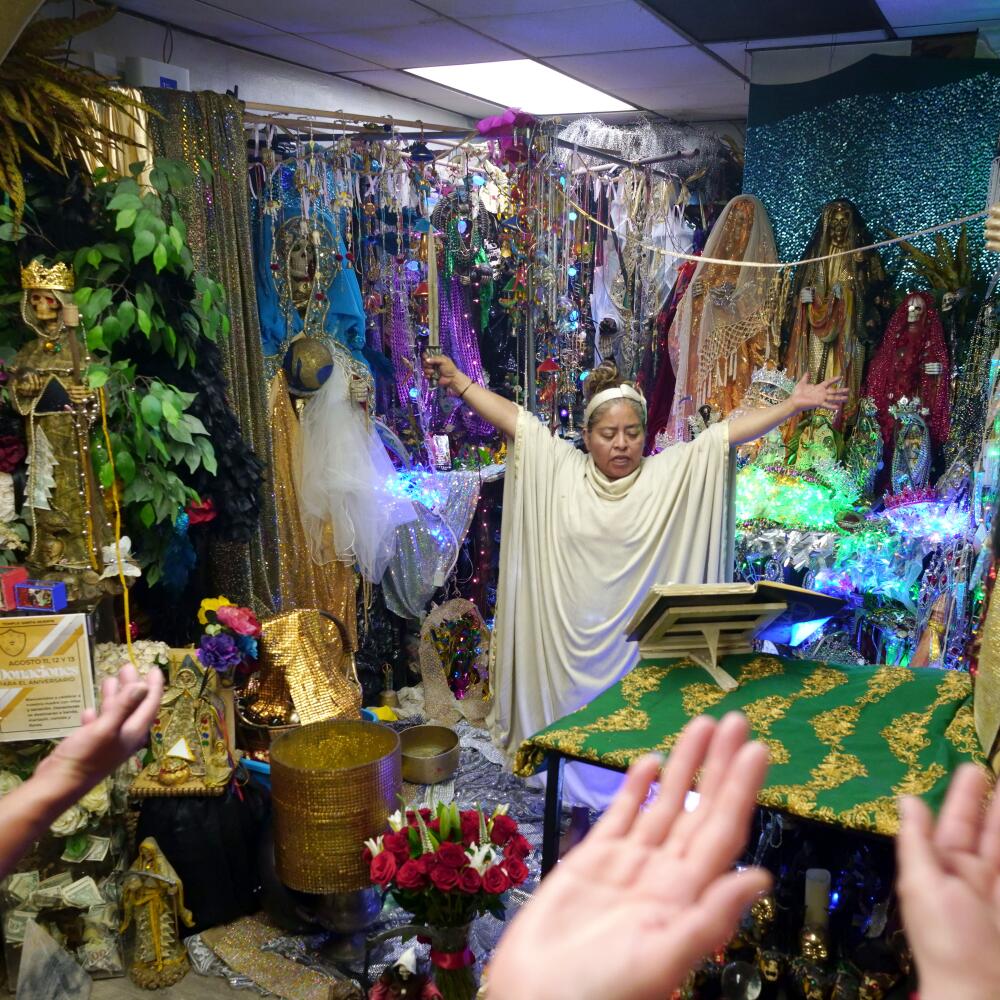
Inside a small storefront on Melrose Avenue, about two dozen people gathered on a recent Friday evening for Mass, raising their arms as they prayed for peace, strength and the ability to “obtain true freedom and eternal inheritance.”
They brought flowers as offerings, recited “Padre Nuestro” and “Ave Maria” prayers, and pleaded for humans to be more conscientious “so that they don’t destroy the planet.” A sign outside the space advised the public to refrain from using inappropriate language out of respect for the temple.
This is what a weekly rosary service looks like for Santa Muerte — a Catholic folk saint, known as La Cumplidora — and they’re becoming increasingly popular in both Mexico and the United States.
“We’re mere mortals,” said Elodia Salvador, who led the service and who has operated Templo Santa Muerte on Melrose for 17 years. “We’re humans who make mistakes, but [Santa Muerte] gives us the opportunity to move forward.” Salvador goes by her spiritual name, Sahara Garcia.
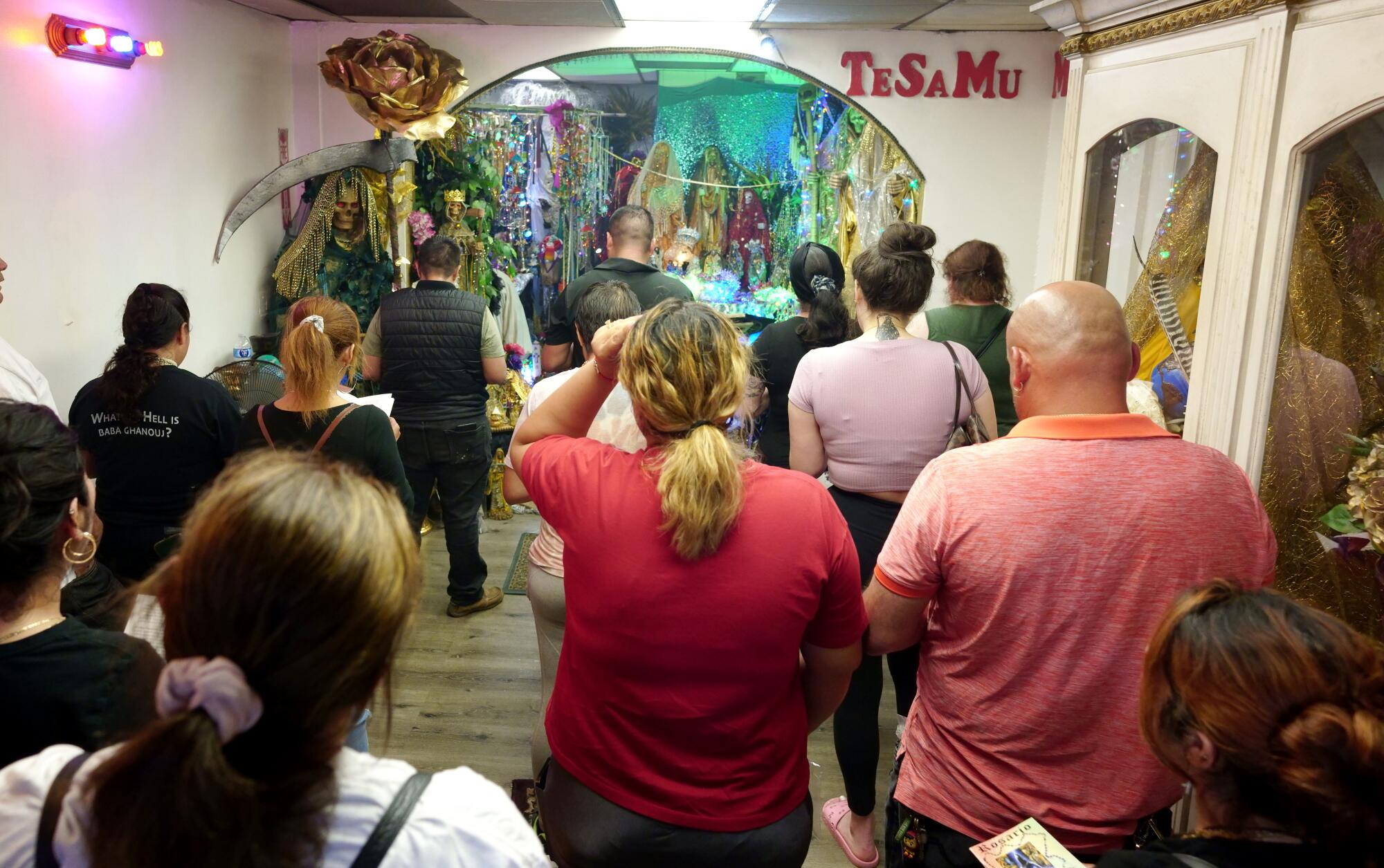
The congregants came from Alhambra, North Hollywood and Santa Ana. “We get along like family here,” said Rony Artica, 48, who’s been coming to the temple since 2017. “Here, I find love and peace.”
Artica, who is from Honduras, said he became a Santa Muerte devotee to break a curse against him that provoked bad dreams and thoughts about death. He had a Santa Muerte statue sent to him from Mexico and he’s been devoted ever since. He still identifies as Catholic but, he said, “I come here first.”
Devotion to unsanctioned Catholic folk saints, specifically to Santa Muerte, has been dubbed “the fastest-growing new religious movement in the Americas” as Catholicism continues to lose more Latinos than any other religious group. While Catholicism remains the largest faith among Latino adults, those who feel estranged from Catholic church traditions are turning to unofficial saints, seeking healing from racism, sexual violence and poverty.
Started by millennial activists, the Avocado Heights Vaquer@s are helping mobilize equestrian communities to fight expansion that threatens an agrarian way of life.
Catholic leaders from the Vatican, Mexico and the U.S. have denounced folk saints like Santa Muerte as “antithetical” and have regarded devotion to her as a “degeneration of religion.”
In a 2016 visit to Mexico, Pope Francis alluded to Santa Muerte, cautioning those who “praise illusions and embrace their macabre symbols to commercialize death in exchange for money,” according to author William Calvo-Quirós in his recently released book, “Undocumented Saints: The Politics of Migrating Devotions.”
The rigorous process the Catholic Church enforces toward canonization, which examines the life and holiness of a candidate, can take years or even centuries.
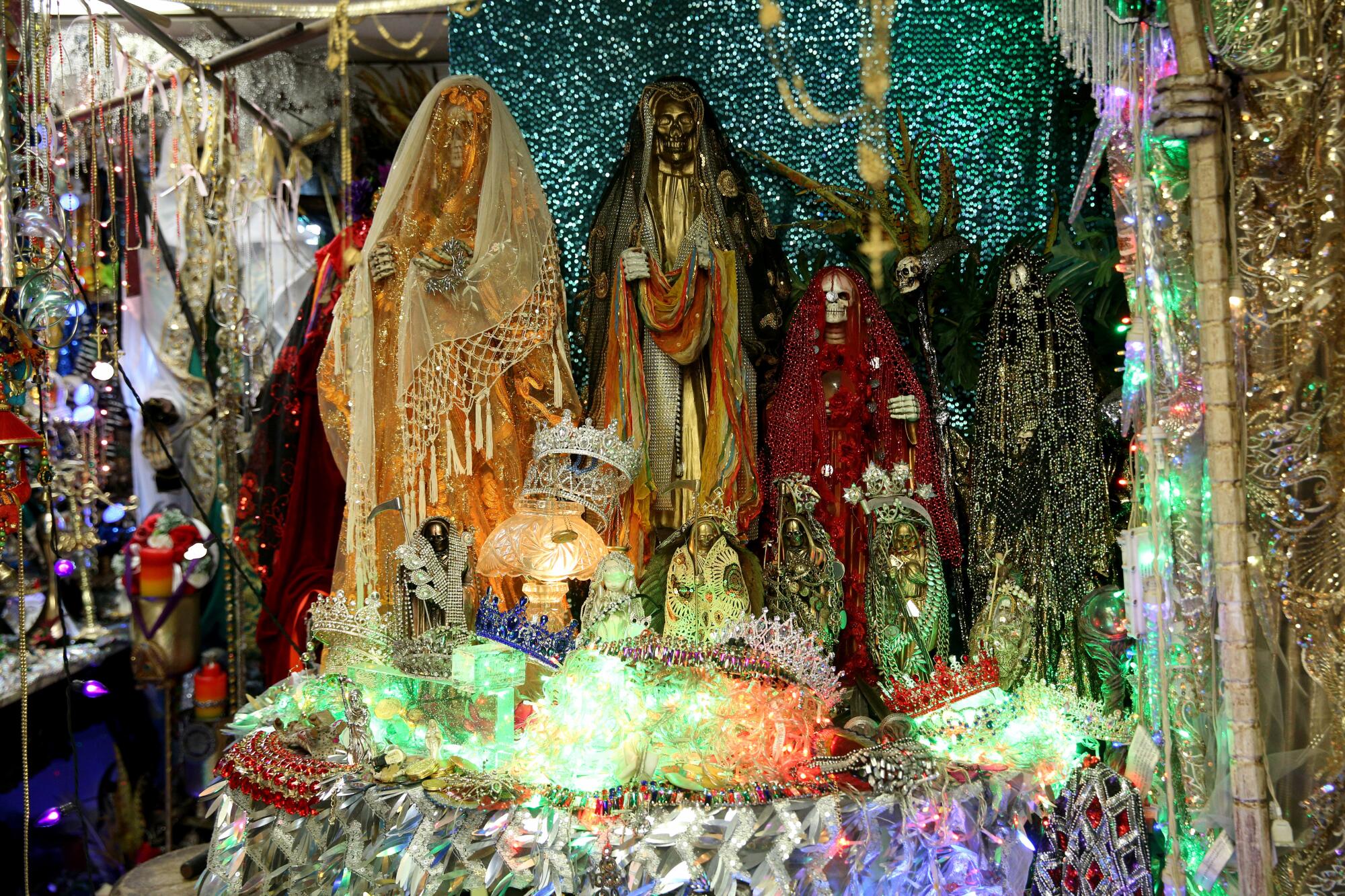
Saints inspire hope that things could get better, that a job could be granted or that justice could be served, writes Calvo-Quirós, an assistant professor of American culture and Latinx studies at the University of Michigan.
“Until sexism, homophobia, and all those things remain part of the rhetoric of the church, people are not going to feel welcome, and they’ll go find other places,” he says.
In his book, Calvo-Quirós traces the migration of popular saints from Mexico into the U.S. and the evolution of their meaning. Saints are everywhere but usually emerge in spaces of distress, he writes.
Jesús Malverde, known as the “generous bandit,” serves as a local saint for peasants and farmers grappling with the effects of modernity in Sinaloa, Mexico. While there are no official records of Malverde, he has become infamous as the narcotrafficking saint.
Santa Muerte’s modern emergence in 2001 coincides with the implementation of the North American Free Trade Agreement and the Tequila Crisis. Santa Muerte has a large LGBTQ following due to the “saint’s zero-tolerance policy on discrimination,” according to R. Andrew Chesnut, author of “Devoted to Death: Santa Muerte, the Skeleton Saint.”
Whether they’re official or not, “Popular saintly devotions can still be profoundly Catholic,” Calvo-Quirós writes. “Devotees may identify themselves as Catholics, cultural Catholics, exiles, or other types of dissidents.” Many Santamuertistas, Calvo-Quirós notes, believe that through Santa Muerte, “They achieve a spiritual connection with God.”
For over 180,000 Ecuadoreans in New York City, ecuavoley, a sport from their homeland, brings together identity, community and an opportunity for mutual aid.
At Botanica del Indio in Boyle Heights, Pablo Espinoza displays life-size statues of Malverde, Santa Muerte and the Virgen de Guadalupe. Customers stop in to buy statues and candles or to get a tarot reading.
Espinoza said Malverde devotees believe the saint has helped them economically, while Santa Muerte can be seen as a symbol of protection. As for Espinoza, he believes in God and the Virgen de Guadalupe. He’s never at Mass, though.
“If I want to talk to God, I can do that without going to church,” he said. “I may not be Catholic, but I believe in God.”
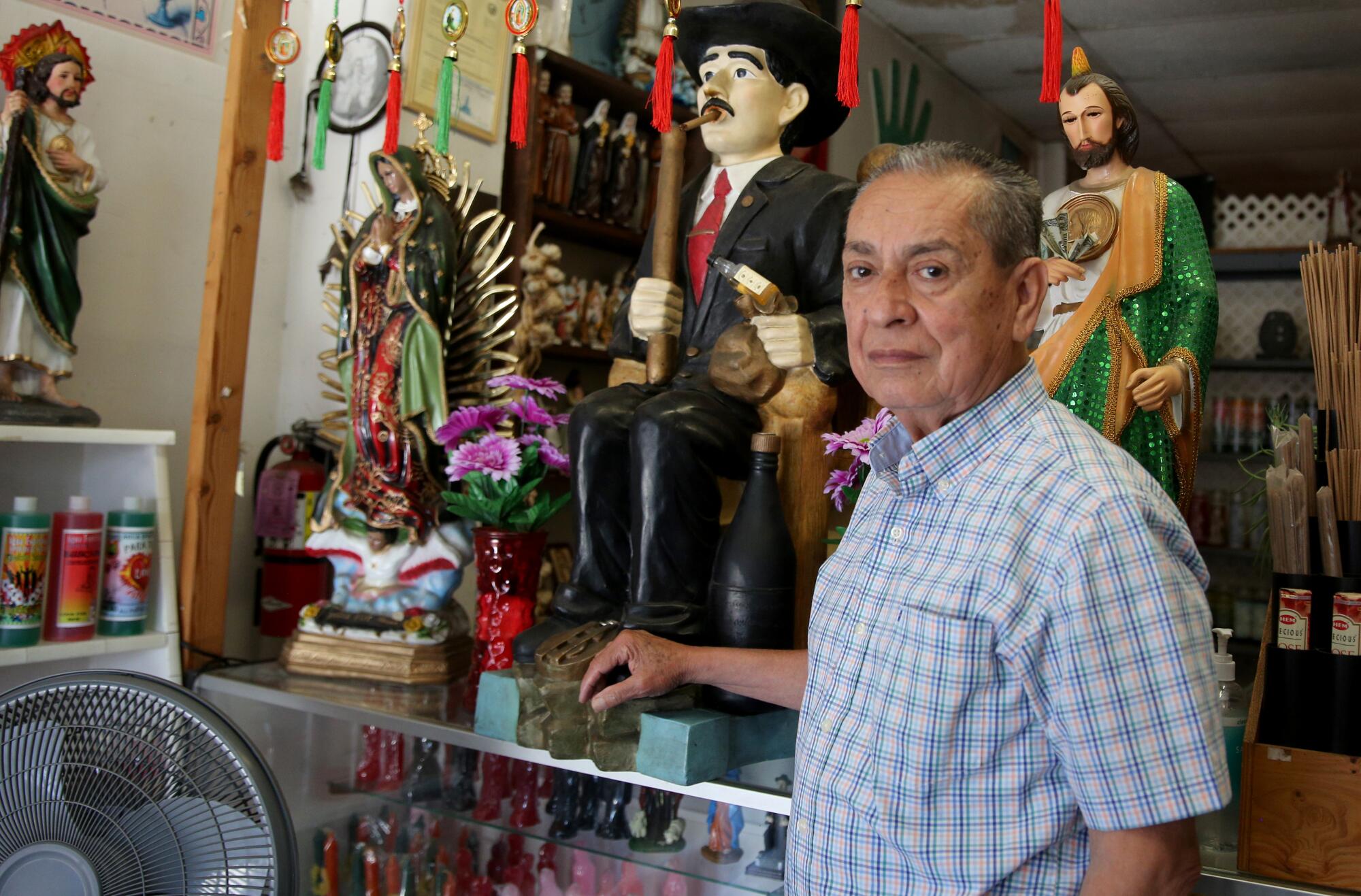
For the record:
10:52 a.m. July 12, 2023An earlier version of this article used feminine pronouns for Erika Del Carmen Ruiz. Del Carmen Ruiz uses the nonbinary pronouns they/them/their.
With Santa Muerte, Erika Del Carmen Ruiz, of San Bernardino, said it’s easier to reconcile their queerness with their Catholicism. “I have been able to find a place where both of those things can coexist as true to me,” they said.
Del Carmen Ruiz, who was born in the U.S. to Mexican parents, was raised Roman Catholic. They went to church every Sunday, acted as an altar server and taught catechism to 4- to 6-year-olds. They loved the tradition and symbolism of Catholic Mass, but took a step back from it as they began grappling with their queerness.
“I was trying to understand my identity, feeling like I didn’t have a place in Catholicism,” said Del Carmen Ruiz, 27, who is now a follower of folk Catholicism.
However, they held on to the Virgin Mary and created an altar for her at their home. They became curious about Santa Muerte, bought a candle with her likeness and placed it on their Virgin Mary shrine. The candle, they said, pulled a strong and energetic current and “became the loudest thing on my altar.”
Soon after, they started a devotional practice to Santa Muerte, learning from a mentor who had been devoted to her for years. Flowers, tequila, apples and other sweets are common offerings.
“There has to be intentionality with what you give her. … When you give her food, that’s to bring financial security and stability. When you give her tequila, that could be used to bring clarity to a situation,” they said. “I give her a candle and water regularly if I’m not trying to pull her energy in a certain direction.”
Becoming your family’s translator of what life is like in El Salvador and the realities of the U.S. takes a toll.
Del Carmen Ruiz said they share many similarities with other Santa Muerte devotees. Many hold leftist and anticapitalist views or are at different intersections of queerness, they said. They think these practices are gaining followers.
“People are just not feeling accepted within that box that the Catholic Church is desperately holding onto,” they said.
Back at Templo Santa Muerte, the faithful are getting ready to honor the deity on Aug. 13. It will be a three-day event celebrating the start of a new year. They’ll have mariachi and banda music.
In the past, they’ve taken offerings to the sea or a river, preferably under a tree, to start anew and let go of everything that hasn’t worked out, said Sahara Garcia.
With time, she said that true believers of Santa Muerte begin to learn how to “illuminate their own path” through their devotional practice including the lighting of candles.
To believe in Santa Muerte is to believe in yourself, she said.
Watch L.A. Times Today at 7 p.m. on Spectrum News 1 on Channel 1 or live stream on the Spectrum News App. Palos Verdes Peninsula and Orange County viewers can watch on Cox Systems on channel 99.
More to Read
The Latinx experience chronicled
Get the Latinx Files newsletter for stories that capture the multitudes within our communities.
You may occasionally receive promotional content from the Los Angeles Times.

